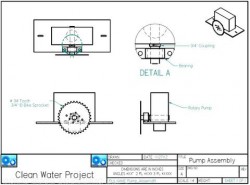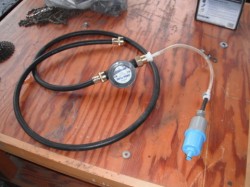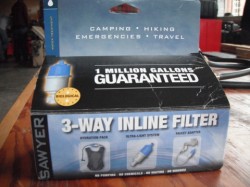Clean Water Project
“Pedaling our way to a cleaner future”
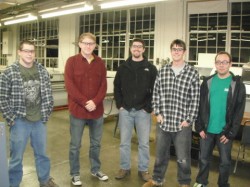
Abstract: Water is essential for human and domestic life yet millions of people throughout the world do not have adequate drinking water. Water in third world countries is plagued with micro-bacteria such as malaria, typhoid, cholera, Guinea worm, E. coli, Giardia, amoebas, and other parasites. This causes the death of millions of people annually and hinders the development of communities.
- Reliability – Our product is intended for third world use where tools and electricity may not be readily available. Our product must therefore be durable and able to withstand extended use.
- User Friendliness – We want to keep our design simple and effective so that people of various education levels will be able to operate and maintain it. We also want the product to be usable by kids and adults alike.
- Portability – The filtration system must be easily transported to and from water sources.
- Cost Effectiveness – Cost must justify production.
- Life Expectancy – Our filtration system must be adapted for extended use and must be easily maintainable.
Links:
Click the link to see our fall schedule. Fall Project Management Plan
Click the link to see our spring schedule. Spring Project Management Plan
Click the link to see the team’s progress via photos. Clean Water Project Photos
Click the link to see our bill of materials. Bill of Materials
Progress…
Week of 5-1-13: The team gathered to create a presentation and poster about the project. Group members met with our customer and other interested parties about our progress. On Wednesday May 1st the group gathered in cloke plaza to display our final product.
The team also made a presentation at Little Hall about the extended progression and development of the project.
Week of 4-13-13: Team members McMullen, Ruff and Plumley went to Mike’s Autobody shop to get a section of the Shurflo water pump housing cut. Team members Pooler and Stevens went to the home depot to get a spring door hinge for the friction drive. The spring door hinge was fastened onto the bike rack and a steel plate was manufactured to connect the hinge to the pump housing.


We are pleased to report that our system is now successfully filtering water. We achieved a flow rate of 1.65 Gallons/Minute which exceeded our expected value of 1.18 Gallons/Minute. This is mostly likely a result of the pump running at a higher RPM then expected. http://www.youtube.com/watch?v=d1cFGDQp3lM&list=LLyJa3jQJjhAcWijxFX0l1xg Note: This video is embedded from Youtube. Week of 4-6-13: In the last few weeks a lot has changed. We have ran into many problems and had to redesign a lot of our project. The first task was getting a pump that was able to produce between one to two gallons per minute of flow through our filter. To do so, we needed a pump that could produce between 30 and 60 psi. We did countless hours of searching and finally found a pump that met our goals. The pump is a Shurflo 8000-543-236 Diaphragm water pump, which can achieve pressures of up to 60 psi and flows of up to 1.80 GPM. In the following graph below we plotted the pressure vs flow curve from the data provided to us by higherpowersupplies.com
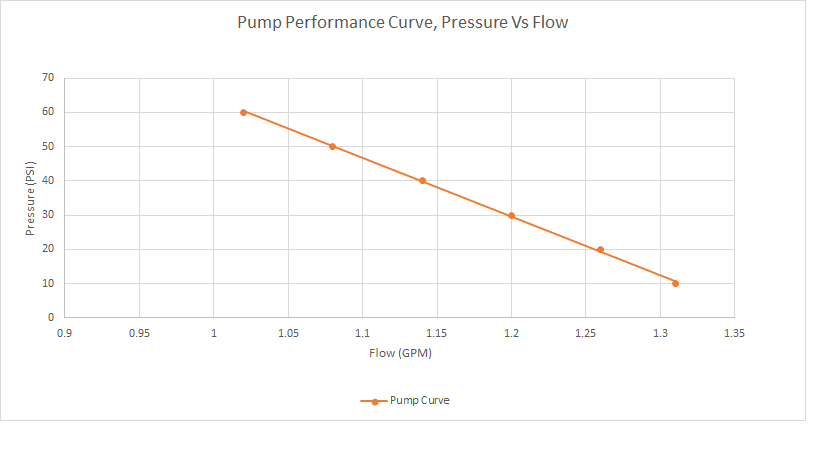
We then compared the Shurflo 8000-543-236 pump performance curve to our system performance data for our McMaster-Carr 8931T22 water filter and housing. Where the two curves intersect, we find our single point of operation.
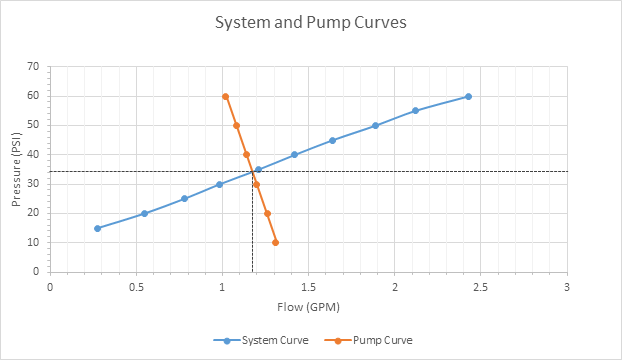
Our single point of operation occurs at a pressure of 34 PSI, where the setup will achieve a flow rate of 1.18 GPM. Using the equation Power = Flow x Pressure our calculated horsepower at this point is .0243 Horsepower. These numbers fit our goals, however the pump is powered by electricity. To overcome this obstacle we plan to convert the pump to be driven by friction. We will take out all of the electrical components and just leave the outer case and drive shaft. Then we will cut a slot in the casing so the back tire of the bike can friction drive the pump. The next problem we ran into was attaching the pump to the bike. We decided we would have to do some calculations to see how much force was needed for a friction drive. After we did the calculations, we figure it would take approximately one pound of force to hold the shaft against the tire. We ordered and received our new Shurflo 8000-543-236 diaphragm water pump. We hooked it up to our water filter and used the electric motor to test the pump. We received approximately 1.3 gallons per minute through our filter, though this was not an official test.. Since we knew the pump worked, we took it apart to figure out how to convert it into a friction drive. After removing all of the electrical components all we had left was the outer casing and drive shaft. We wrapped cloth tape around the drive shaft for a better friction surface and to cover up all the sharp edges. Now we are in the process of cutting a slot in the casing and mounting the pump. Week of 3-18-13: During break Jamie was not able to fix the pump, he did clean out the pump and test it in multiple configurations. Tim McMullen made a professional wood stand for the bike which we stained and sealed when we got back. Matt, Travis, and Zachary researched and found many good pump replacements with various flows and pressure outputs. We managed to get flow out of the pump again after we gathered again, and have assembled everything on the bike. The pump doesn’t produce enough pressure to produce the required flow through the filter. We do have a working prototype that will pump water and filter it down to .15 microns, only at a reduced flow rate. Week of 2-25-13: By moving the bike stand’s bike support in towards the axle, we stopped the bending moment from damaging the rear axle. We used a liquid silicone gasket on the pump housing to try and seal the leaks. Unfortunately the pump stopped working and has since refused to produce any pressure or flow. We have disassembled the pump many times to look for problem. The general consensus is that the extra silicone gasket has made its way into the pump and is causing the pump to lose suction. Over spring break Jamie Plumley will try and fix the pumps flow problem, Timothy McMullen will assemble a more appropriate bike stand for the final project. Matt Stevens, Zachary Pooler, and Travis Ruff will look for a replacement pump in case the current one can not be fixed and the pressure problem can not be solved. Week of 2-11-13: Jamie Plumley and Timothy McMullen made a trip to Bangor to try and find appropriate fittings for the pump. We managed to find a very helpful employee at N. H. Bragg and Sons who re-threaded the inlet and outlet for us so our pump will now accept the fittings to our hose. The team has tested the filter and pump assembly and a problem occurred with the pump leaking from the seams. A bike rack was obtained which we can now attach the flow system onto and attach it all to the bike. A mock up of the stand we will use to prop the bike up off the ground while driving the pump has been built. We tested the stand by propping the bike up, sitting on the bike, pedaling, and observing what happened. We noticed that because the bike stand was so wide, the rear axle had a great bending moment on it and could deform or break. The stand was made this wide to provide great stability but we noticed that this was over done and the stand could be narrower to reduce the bending moment. Week of 1-28-13: The team has decided on a new cartridge filter bought on McMaster-Carr that filters down to .15 microns and will be easily installed into our system. The filter will have a 3/4 inch inlet and outlet to allow for adequate flow of up to one gallon per minute. The team edited solid edge files to show updates in the design for our 3D model. A team plan has been drawn up to help keep us on track as we will be nearing the completion of this project. We met with our intended customer, Finely Richmond, to discus where our project is going and to make sure that he is in favor of our current goals. Week of 1-14-13: The team meet to discuss our semester plans and to assemble the new pump. We attended a lecture by Carolyn Meub on clean water for the world, where we talked to her about our project and some of the complications we would face with our bicycle. We discussed what replacement filters we could use and researched alternative ways to filter the water. By next week we should have a new filter to test. Week of 12-10-12: We met with Catherine Hopper from The University of Maine’s Micro-Biology department to do a test of the teams purchased water filter. We ran three tests of 5 log concentrated E. coli solutions through the filter to measure its effectiveness. The filter failed to remove all of the E. coli solution, we were left with 2 log E. coli concentration so another filter will need to be found. Jamie drew a scale model on a poster board highlighting how the chain drive system will work with our pump. The team made solid edge drawings of our bike with pump and attachments. 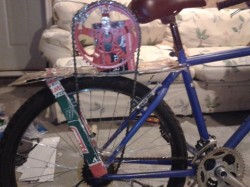
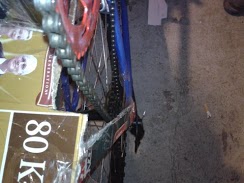 Chain clearance (click to enlarge) Chain clearance (click to enlarge) Week of 12-03-12: The entire group met to build a full size cardboard mock-up of our water filtration system. The purpose of this mock-up was to determine whether or not we had adequate clearances for our two chain system. A metal sprocket was attached to the sleeve bearing and a chain was added. We determined that the second chain would clear all components of the system on the second smallest gear. We also decided that we would be disengaging the chain derailleur in the back to avoid the shifting of gears which would cause chain interference. The chain is still free to shift between the front three gears of the bike.
Chain clearance (click to enlarge) Chain clearance (click to enlarge) Week of 12-03-12: The entire group met to build a full size cardboard mock-up of our water filtration system. The purpose of this mock-up was to determine whether or not we had adequate clearances for our two chain system. A metal sprocket was attached to the sleeve bearing and a chain was added. We determined that the second chain would clear all components of the system on the second smallest gear. We also decided that we would be disengaging the chain derailleur in the back to avoid the shifting of gears which would cause chain interference. The chain is still free to shift between the front three gears of the bike.
Week of 11-26-12: We calculated the ideal flow rate for our pump and how much horsepower needed to do so. Also, we completed the bill of materials including all the parts our current design will have. Third, we made a presentation of our product that we presented to our class and teacher, informing them of our overall goal, and where we are in the process right now. Finally, we completed preliminary 3-D CAD drawings of our product, drafts, and assembly views.
Week of 11-12-12: Our filtration system will be attached to a rack on the back of a bicycle and will be chain driven. The bike will be able to be ridden when not pumping water, making it easier to transport the filtration system. When you want to engage the filtration system, simply lift the back tire off the ground using our stand, engage the pump via two pins in our drive sprocket, and pedal the bike. This seems to be the most ergonomically efficient way to pump water through our filtration system with minimal effort. Also this week, we measured pressure at different flow rates of water through our filter, calculated power, and put all this data on a graph. This data will help us understand how much power we need to produce to get a certain flow rate. The team also started a parts list of the items we have to make and purchase.
Week of 11-5-12: Our most recent design has been decided on which will be a rotary pump hooked up to a shaft driven by the back sprocket of a bike. The whole system will sit on the back of the bike which will make it easily portable. You will be able to ride the bike to where ever the water source is, drop a hose, lift the rear tire, and start pumping water. By pedaling, the rotary pump will spin and force water through the filtration system. A mock up has been made using a stationary bike to prove the concept.
Week of 10-22-12: Team members have made more drawings of designs that we possibly can use for our filtration system. The team has decided to use a rotary pump connected to a bicycle to pump the water which will make it physically easier to use. Also, the filter has been purchased and tested for how much flow it can handle. When hooked up to a sink faucet, the flow rate through the filter was 1.20 gallons per minute. The team made a small mock-up of the filter and rotary pump. For the mock-up, we used a rotary pump that was powered by a drill to see if the concept would work. The test confirmed our hypothesis.
Week of 9-17-12: The team decided to make a pump that could be hooked up to a pre-existing filter that could clean water from contaminated rivers, streams, ponds, and any other available water sources. The idea is to make a piston-like pump controlled by a rotary handle instead of the normal up and down motion. This will be unlike most pumps out there and hopefully will make it a lot easier to pump water. The team has researched several patents and could not find any pump like the one we are planning on building.
About The Team…
Matthew Stevens (Resume): Matt is a fourth year Mechanical Engineering Technology student. He is interested in many facets of engineering including Fluid Mechanics, HVAC, and Engine Design. He strives for achievement in both physical and academic endeavors, and plans to take the Fundamentals of Engineering exam in the spring. Matt sees the Clean Water Project as an opportunity to contribute to others, while also challenging real world engineering skills. Whether it be researching concept designs, or building prototypes, Matt is looking forward to working with his team to solve the many obstacles that lie ahead. Tim McMullen (Resume): Tim is a 4th year Mechanical Engineering Technology student at the University of Maine and is expected to graduate in May of 2013. He was born in Massachusetts and moved to Hudson, NH where he was raised. Tim graduated from Alvirne High School in 2009 where he first got interested in mechanical engineering by taking a few drafting and CAD classes. This is where he was informed about and joined First Robotics. He has knowledge in HVAC and industrial vibrations and hopes to obtain his dream job as an amusement park engineer. Tim worked this past summer as a machine operator at Sea Stones, where he made granite drink chillers, coasters, ice cubes, and various other items. Outside of academics, Tim finds amusement in a wide variety of sports and carpentry. Tim is looking forward to the Clean Water Project and hopes it can help many areas of the world where clean water is hard to come by. Zachary Pooler (Resume): Zach is a fourth year Mechanical Engineering Technology student. He has interned at the Portsmouth Naval Shipyard working on state of the art environmental sensing units that interface with Labview, allowing security personnel to monitor the sensors from their computers. With the use of Autodesk Inventor, Zach engineered a one of a kind chlorination manifold for heat exchangers that utilize seawater for cooling. The chlorination manifold helps prevent bacteria growth on the inside of the pipes, allowing for unrestricted flow. He has also composed a training bill and provided training to officers and sailors on how to operate the housing unit that sits over the hatch of submarine. This unit is responsible for supplying fresh air to the workers, exhausting stale air, providing low pressure air for pneumatic tooling and emergency shutdown. Utilizing his skills in 3D modeling (Solid Edge, Solid Works, AutoCAD) Zach created a parts library for all the temporary services utilized by the Portsmouth Naval Shipyard. When Zach is not focused on advancing his carrier he enjoys spending time outdoors (hunting, fishing, four wheeling, hiking etc.). Zach hopes to use the fundamental knowledge gained from school and skills acquired through industry to help The Clean Water Project go above and beyond their goals of creating a portable, cost efficient pump capable of filtering out bacteria as small as .15 microns. Travis Ruff (Resume): Travis is a 4th year Mechanical Engineer Technology student at the University of Maine. Travis expects to graduate in May 2013 and is looking forward to pursuing a career in engineering. Travis is from a small town called Rumford, which is located in the western foothills of Maine. He has been working at New-Page for the last 3 summers. New-Page is a pulp and paper mill that has several mills across the U.S. Travis learned a variety of skills working in an industry type environment, along with key skills that will help him in his career. Travis has several hobbies ranging from sports to hunting and fishing. Travis is extremely excited to construct a filtration system may help thousands of people around the world. Jamie Plumley (Resume): Jamie is currently in his fourth year of Mechanical Engineering Technology at the University of Maine. His interests include design, amateur rocketry, and automotive engineering. Some of his strengths are innovative problem solving and strong customer service skills. Jamie grew up in the central New York town of LaFayette. He strives for excellence in his academic career while keeping time for hobbies and activities. During the summers of 2010 and 2012 he worked as a TA at Syracuse University in Environmental Engineering. Jamie is on track to graduate with a bachelors of science in May of 2013.
More about Team Clean Water:
The goal of The Clean Water Project is to produce a water filtration system that is cost effective yet reliable. The system will include a water pump that interfaces with a cartridge filter to remove micro-bacteria down to 0.15 microns. The whole system will be powered by a bicycle. In order to achieve our goal, we broke the project down into four sections. We must have a working product by May 1st, 2013. Section 1: Concept Design Section 2: Benchmarking Section 3: Calculations and Specific Design Section 4: Final Product Section 1 – Concept Design Our first and most prevalent concern is the safety of our intended users. Therefore proper filtration is paramount. The two ways one can eliminate bacteria from a water source is by sterilization or membrane filtration. Methods of sterilization include boiling the water and the use of UV lights. Membrane filtration is a way to strain out micro-particulates from water using a very fine mesh-like material. Much of the water in Haiti is already sterilized by boiling. However, due to limited fuel supplies, boiling is often not available. UV lights require electricity, which is not available for our customers. Therefore filtration via membrane is the best solution. Our next area of concern is how we would move the water through the filter. We looked at many electrical and hand powered pumps including piston pumps, centrifugal pumps, diaphragm pumps, and rotary pumps. Piston pumps are effective and simplistic but they are hard to use for extended periods of time. We determined an electric powered diaphragm pump used for agricultural spraying would be the simplest way of pumping and cleaning water due to adequate flow and pressure. We will have to cut open the motor and turn the electric motor into a friction drive powered by the rear wheel of a bicycle. Section 2 – Benchmarking To design a new and unique way of filtering water, we had to do a lot of bench marking. We spent countless hours researching patents and other designs without patents. Since we found many patents for water filtration systems, we decided to create a product that sets us apart from all others. Through brainstorming, we decided to use a bicycle to run the pump that will push water through our filtration system. Current marketed bicycle designs have very complicated and expensive means of pumping and filtering the water. Our idea is to make a cheaper version by simplifying the design, but not compromising pumping power and filtration specifications. Section 3 – Calculations and Specific Design Our design is to use a common, stiff frame, mountain bike as our base. The mountain bike will be fully functional when all of our parts are attached to it. The pumping and filtration system will be attached on a bicycle rack that sits above the back tire. The pump will be attached to a hinge that will let it sit on the bicycle rack when not in use. When in use, the pump will be able to flip down onto the back tire and held there by springs so the drive shaft of the pump can be friction drove. Our filtration system will be connected to the pump via nylon tubing and necessary fittings. We will have a suction strainer with a check valve connected to the hose that is placed in the unfiltered water source. On the other end there will be a 0.10 micron filter. To pump the water you simply put the bike up on a stand that will be attached to the rear axle. This will hold the back tire off of the ground and allow it to spin free. Simply sit on the bike, pedal, and watch as the dirty water enters the system and clean water exits. After your finished cleaning the water, simply kick up the bike stand and your free to go. To see drafts of our design, view our photos. Patent-able parts: Spring Loaded Friction Drive: The electric water pump we will be using has been converted to a friction drive water pump. The spring loaded friction drive is our patent-able feature. The drive shaft of the electric motor and housing is all that will be left of the motor. There is a wheel on the motor that will be wrapped with a high friction material so the rear tire of a bicycle will be able to spin the shaft. The motor will be attached to a spring loaded hinge that will be attached to the bicycle rack. When the pump is not being held onto the rack, the spring loaded hinge will create enough force to hold the drive shaft to the tire. A simple yet effective design that will be exactly what our design calls for.


